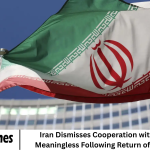Global markets are once again trembling under the weight of escalating tensions between the world’s two largest economies—the United States and China. What began as a series of tariffs and countermeasures has now evolved into a full-fledged trade war that is shaking investor confidence.
- The Spark That Ignited the Latest Escalation
- Market Reaction: A Day of Chaos
- Corporate Impact: Multinationals Caught in the Crossfire
- Global Economic Consequences
- Slower Global Growth
- Disrupted Supply Chains
- Inflationary Pressures
- Decline in Business Confidence
- Strain on Emerging Markets
- Political and Strategic Dimensions
- The Currency Factor: A New Front in the Trade War
- Global Repercussions Beyond the U.S. and China
- Technology and National Security: The Hidden Battle
- Investor Outlook: What Comes Next
- Frequently Asked Question
- Conclusion
The renewed volatility underscores the fragility of global trade relations and highlights how deeply interconnected economies have become. From Wall Street to Shanghai, the consequences of tariff-driven politics are reverberating through industries, boardrooms, and households alike.
This article explores the latest escalation in the U.S.–China trade war, examines its global impact, analyzes investor reactions, and discusses what lies ahead for businesses and consumers in an increasingly protectionist world.
More Read: Aston Martin Shares Plunge 10% After Profit Warning Amid Tariff Turmoil
The Spark That Ignited the Latest Escalation
The Trump administration has long accused China of unfair trade practices, intellectual property theft, and currency manipulation. In response, Washington has imposed a series of tariffs targeting hundreds of billions of dollars’ worth of Chinese imports—ranging from electronics and steel to consumer goods.
In the most recent move, the United States announced a new wave of tariffs on $300 billion worth of Chinese products, effectively covering almost all Chinese exports to America. The tariffs, set at rates between 10% and 25%, are intended to pressure Beijing into agreeing to U.S. demands for structural economic reforms.
Beijing’s response was swift. The Chinese Ministry of Finance announced counter-tariffs on $60 billion worth of American goods, including agricultural products, chemicals, and machinery.
China also suspended purchases of U.S. soybeans and other key commodities, signaling a willingness to endure short-term economic pain in order to resist U.S. pressure.
The tit-for-tat actions mark a significant escalation in the trade conflict, pushing the world closer to a scenario where both nations—and by extension, the global economy—suffer substantial long-term damage.
Market Reaction: A Day of Chaos
Financial markets reacted sharply to the news of China’s retaliation. Investors fled to safe-haven assets such as gold, government bonds, and the Japanese yen. The U.S. stock market saw one of its steepest single-day declines in months, reflecting deep concern about the potential fallout for global growth and corporate profits.
- Dow Jones Industrial Average: Dropped by more than 700 points, its worst decline in nearly a year.
- S&P 500: Fell 2.8%, erasing weeks of gains.
- Nasdaq Composite: Plunged 3.4%, driven by heavy losses in technology and manufacturing stocks.
- Global Markets: London’s FTSE 100 and Japan’s Nikkei both fell over 2%, while Hong Kong’s Hang Seng Index lost nearly 3%.
The trade war has already led to significant market volatility in 2025, with investors increasingly uncertain about the stability of global trade policies. Economists warn that if the current trajectory continues, a global recession could become a real possibility.
Corporate Impact: Multinationals Caught in the Crossfire
The trade war is hitting multinational corporations particularly hard. U.S. companies with significant exposure to the Chinese market—such as Apple, Boeing, and Caterpillar—are facing declining sales, rising costs, and increased regulatory scrutiny in China.
- Apple has seen its supply chain disrupted as tariffs raise the cost of imported components.
- Boeing faces a slump in aircraft orders from Chinese airlines.
- Caterpillar has reported a slowdown in global demand for heavy machinery, partly due to uncertainty around trade and infrastructure investments.
On the other hand, Chinese firms that rely on American technology—such as Huawei and Tencent—are also under pressure. U.S. export controls and restrictions on advanced chip technologies are squeezing Chinese manufacturers and slowing innovation in critical sectors like artificial intelligence and telecommunications.
Smaller companies are not immune either. American farmers, particularly soybean and corn producers, have suffered steep losses as Chinese tariffs on agricultural products drive down prices and reduce exports.
Many have turned to government relief programs, but the uncertainty surrounding trade relations continues to weigh heavily on rural economies.
Global Economic Consequences
The trade war is more than just a bilateral dispute—it’s a global economic event with far-reaching implications.
Slower Global Growth
The International Monetary Fund (IMF) has already downgraded its global growth forecasts, citing trade tensions as a major factor. The IMF estimates that the trade war could shave up to 0.5% off global GDP growth, equivalent to hundreds of billions of dollars in lost economic output.
Disrupted Supply Chains
Manufacturers worldwide are rethinking their supply chains. Many companies are relocating production from China to other countries like Vietnam, India, and Mexico to avoid tariffs. While this diversification provides some relief, it also raises costs and causes logistical challenges.
Inflationary Pressures
Tariffs increase the cost of imported goods, leading to higher prices for consumers. In the United States, prices for electronics, clothing, and household goods are expected to rise as retailers pass on higher costs.
Decline in Business Confidence
Surveys of business leaders show a sharp decline in confidence levels, particularly among exporters and manufacturers. Many are delaying investment and hiring decisions until the trade environment stabilizes.
Strain on Emerging Markets
Emerging economies that depend on global trade, such as Malaysia, South Korea, and Brazil, are also feeling the pinch. Falling exports, weaker currencies, and lower commodity prices threaten to derail growth across the developing world.
Political and Strategic Dimensions
The trade war is not purely economic—it’s deeply political. Both Washington and Beijing view the conflict as a battle for global dominance in technology, manufacturing, and economic influence.
For the United States
President Trump’s administration has framed the tariffs as a necessary measure to protect American workers and industries from unfair competition. The strategy is also politically popular among segments of the electorate who believe globalization has hollowed out U.S. manufacturing.
However, critics argue that the tariffs are hurting American businesses more than they’re helping. Economists warn that protectionism risks isolating the U.S. from global supply networks and reducing its competitiveness in the long run.
For China
Beijing views the trade war as part of a broader U.S. effort to contain its rise as a global power. Chinese leaders have pledged to resist pressure while accelerating domestic innovation and reducing dependence on foreign technologies.
In response, China has strengthened trade ties with Europe, Africa, and Southeast Asia through initiatives like the Belt and Road Initiative (BRI). The country’s leadership is also focusing on boosting domestic consumption and developing alternative markets to mitigate U.S. tariffs.
The Currency Factor: A New Front in the Trade War
Another significant dimension of the trade conflict is currency manipulation. The Trump administration has accused China of devaluing the yuan to make its exports more competitive. When China allowed the yuan to weaken beyond the symbolic 7-per-dollar threshold.
Markets interpreted it as a sign that Beijing was weaponizing its currency. A weaker yuan helps Chinese exporters offset tariff costs, but it also risks capital outflows and financial instability. The U.S. Treasury Department has labeled China a “currency manipulator,” further inflaming tensions.
Analysts fear that if both sides begin using currency policy as a tool of retaliation, the trade war could evolve into a currency war, with devastating consequences for global markets and exchange rate stability.
Global Repercussions Beyond the U.S. and China
While the U.S. and China are at the center of the conflict, other economies are suffering collateral damage.
- Europe: The European Union, already grappling with sluggish growth, is facing additional headwinds from trade uncertainty and supply chain disruptions.
- Japan and South Korea: Export-driven economies are experiencing declining demand for semiconductors and machinery.
- Developing Nations: Countries like Vietnam and India are benefiting from companies relocating production out of China, but these gains are modest compared to the global economic losses.
- Commodity Exporters: Nations dependent on oil, copper, and soybeans—such as Brazil and Australia—are witnessing volatile prices due to fluctuating demand.
The trade war has effectively redrawn the map of global commerce, forcing countries to reconsider alliances and economic strategies.
Technology and National Security: The Hidden Battle
Behind the headlines of tariffs and market declines lies a deeper struggle over technology and national security. The United States has imposed restrictions on Chinese tech giants like Huawei, citing concerns about espionage and cybersecurity.
At the same time, Washington is seeking to limit China’s access to advanced semiconductor technologies, a move that could reshape the global tech industry.
This technological decoupling marks a profound shift in global trade dynamics. Instead of a world bound by open markets and shared innovation, the U.S. and China appear to be moving toward parallel, competing technological ecosystems.
Investor Outlook: What Comes Next
As markets remain volatile, investors are trying to assess whether the trade war will escalate further or give way to renewed negotiations.
Some analysts believe that both sides will eventually seek compromise to prevent further economic damage, possibly through limited trade agreements or phased tariff reductions. Others warn that geopolitical mistrust and domestic politics may prolong the standoff indefinitely.
In the short term, financial markets are expected to remain unstable. Safe-haven assets such as gold and U.S. Treasury bonds are likely to stay in demand, while riskier equities could experience continued pressure.
Frequently Asked Question
What caused the escalation of the U.S.–China trade war?
The escalation began when the Trump administration imposed new tariffs on $300 billion worth of Chinese goods, accusing China of unfair trade practices. In response, China retaliated with tariffs on U.S. products and suspended purchases of key commodities, including soybeans.
How have global markets reacted to the latest round of tariffs?
Markets worldwide tumbled following the announcement. The Dow Jones dropped over 700 points, while Asian and European markets suffered similar declines. Investors rushed to safe-haven assets like gold and government bonds.
Which industries are most affected by the trade war?
Technology, manufacturing, and agriculture are among the hardest-hit sectors. Companies like Apple, Boeing, and Caterpillar face supply chain disruptions, while U.S. farmers have lost major export markets in China.
How does the trade war impact consumers?
Consumers are likely to face higher prices on imported goods, including electronics, clothing, and household products. Tariffs raise production costs, which are often passed on to consumers.
What is the role of currency in the trade conflict?
The U.S. has accused China of devaluing the yuan to offset tariffs and make exports cheaper. If currency manipulation continues, it could evolve into a broader currency war, worsening market instability.
Can the trade war trigger a global recession?
Yes, economists warn that prolonged trade tensions could significantly slow global growth. The IMF estimates that the trade war could reduce global GDP by 0.5%, potentially pushing some economies into recession.
Is there hope for resolution between the U.S. and China?
While both sides occasionally express willingness to negotiate, deep political and strategic differences remain. A resolution is possible but will likely require significant compromise and diplomatic engagement.
Conclusion
The escalating trade war between the United States and China represents one of the most significant threats to the global economy in recent history. What began as a dispute over trade imbalances and intellectual property has spiraled into a complex geopolitical confrontation with far-reaching consequences.
Both nations are feeling the pain—factories slowing production, farmers losing markets, and consumers facing higher prices. Meanwhile, the rest of the world is caught in the crossfire, dealing with the fallout of uncertainty, disrupted trade flows, and weakened investor confidence.














